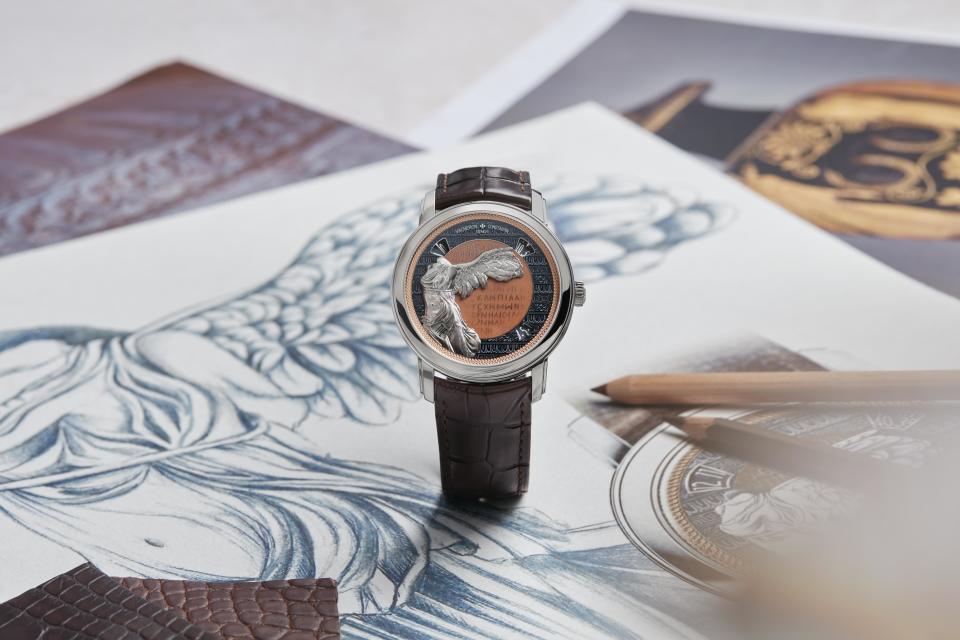Vacheron Constantin Unveils Watches Inspired by Treasures From the Louvre
- Oops!Something went wrong.Please try again later.
- Oops!Something went wrong.Please try again later.

PARIS — Seeing a sculpted goddess extending her wings, or the adorned sarcophagus of Egyptian royalty is an awe-inspiring moment by anyone’s standard.
A lucky few will be able to repeat that experience every time they glance at their wrist, as Vacheron Constantin is unveiling a watch collection inspired by the treasures of antiquity housed in the Louvre in Paris as part of a partnership signed between the watchmaker and the French museum in 2019.
More from WWD
The Métiers d’Art Tribute to Great Civilisations line consists of timepieces figuring the famous winged Victory figurehead found in the Greek island of Samothrace; the Great Sphinx of Tanis, one of the largest ones preserved outside of Egypt; the Frieze of Lions, a glazed brick decoration that once adorned the palace of Persian emperor Darius the Great; and a bust of first Roman emperor Octavian Augustus, the adopted son of Julius Caesar.
Out of the scores of items stored in the museum, covering a period from the dawn of civilization to the mid-19th century, these were chosen because they exemplified civilizations still considered to be the foundation of the modern world and the wealth of culture at the Louvre, explained Vacheron Constantin’s heritage and style director Christian Selmoni.
“It’s not [just] about creating watches together, it’s about exchanges with craftspeople and cooperation from the cultural point of view,” he continued.
All four models embark the Manufacture Calibre 2460 G4/2, which uses disks as indicators. Its oscillating weight features a view of the Louvre’s eastern facade based on an 18th-century etching.
Having four symmetrical apertures to read the time and date instead of hands on the dial opened up the possibilities to combine micro-mosaics, stone marquetry, engraving, metallization on sapphire glass, and champelevé and grisaille enameling, Selmoni explained.
Beyond reproducing well-documented works, the ateliers looked to highlight the most salient artistic feature and the effects of time.
The Victory was therefore shown from the side, as she does in the Louvre, to show the draping work of the original sculptor. Around the Sphinx, the outline of wings painted on a coffin cover were enameled with aging inclusions to replicate the passage of time.
For the Lion of Darius, the glazed bricks were figured using veined fragments of turquoise and yellow mochaite jasper, while an existing mosaic was scaled down to wrist-sized proportions through 660 minute pieces for a Roman-inspired Buste d’Auguste design.
Layered between the dial and decorative figure is a wafer-thin sapphire glass, engraved with a metalized text relevant to each era — in its original script. It gave the effect of a text fading or appearing on a surface depending on the angle of the light.

Courtesy of Vacheron Constantin
As the female collector market and the convergence between men’s and women’s designs continue to grow, Selmoni noted that no consideration had been paid to the gender or location of the future owners of these métiers d’art creations, as decorative crafts have always been an integral part of fine watchmaking.
“There are multiple ways to collect watches but there has always been a group of collectors that has been into decorative crafts and métiers d’arts watches,” he remarked.
To Selmoni, such exercises play a crucial role in the preservation of high watchmaking crafts such as guilloché, engraving, enamel and gem-setting, once at risk of disappearing altogether.
The watchmaker recently spotlighted them at the “Homo Faber” métiers d’art exhibition in Venice, where it showed its “Thunder God” and “Wind God” minute repeater timepieces, which were part of the one-off Les Cabinotiers line.
“We see a growing interest for the ultimate expression of fine watchmaking, which is a combination of technicality — from movement to hand-finishing — and decorative crafts,” he said, noting that the majority of bespoke requests were a combination of complications and creative crafts.
The Vacheron Constantin Métiers d’Art Tribute to Great Civilisations watches will be produced in a limited edition of five each, with prices on request.
Sign up for WWD's Newsletter. For the latest news, follow us on Twitter, Facebook, and Instagram.

